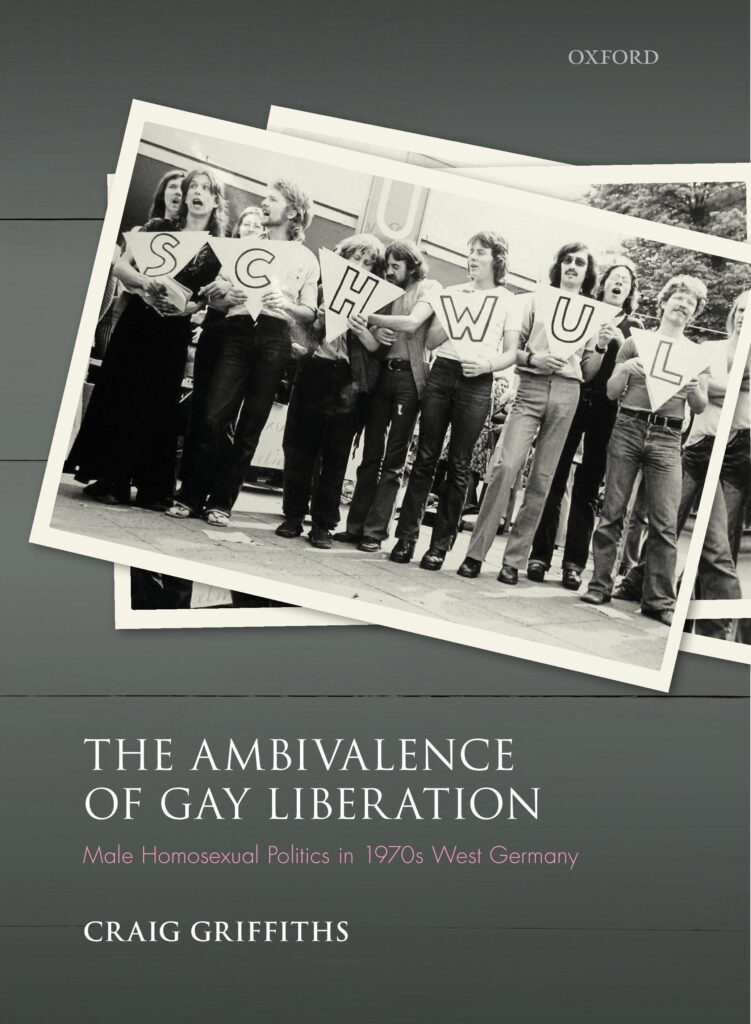Craig Griffiths
The Ambivalence of Gay Liberation: Male Homosexual Politics in 1970s West Germany explores ways of thinking, feeling and talking about homosexuality in the 1970s, between the partial legalisation of sex between men in 1969, and the arrival of the HIV/AIDS crisis in the early 1980s. By drawing attention to ambivalence, the book shows that gay liberation was never only about pride, but also about shame; characterized not only by hope, but also by fear; and driven forward not just by the pushes of confrontation, but also by the pulls of conformism.

Notches: In a few sentences, what is your book about? Why will people want to read your book?
Craig Griffiths: In part, my book is about the gay movement in 1970s West Germany, a movement made possible by homosexual law reform in 1969. But rather than looking narrowly at a social movement, it examines the turbulent and conflicting ways homosexuality was thought about and discussed in the 1970s – in the media, in the commercial gay press, on television, in parliament. I show that ways of thinking and talking were not disconnected from ways of feeling about homosexuality.
My aim is to call into the question the idea that 1969 marked a profound rupture in queer history (whether we have in mind homosexual law reform in West Germany, or the Stonewall riots in New York City). Gay liberation was never some utopian, radical, hedonistic interlude. After 1969, shame was not vanquished by pride; the pushes of revolt and resistance sat uneasily alongside the pulls of convention and the desire to be accepted. Gay men’s ambivalence about themselves, their desires and the society in which they lived is at the heart of this book. Hopefully, this will appeal particularly to those interested in modern queer history and the history of sexuality. My book also addresses a wider story about the ambivalence of a political culture; that of mainstream West German society but also that of alternative left, of which gay liberation, somewhat precariously, was a part. So I aim for this book to speak more broadly to those interested in modern German and European history too.
Notches: What drew you to this topic?
CG: The scholarship on gay liberation remains quite dominated by the Anglo-American context, whereas queer historians of the German-speaking world have tended to focus on nineteenth-century sexology, or on homosexual emancipation in the early twentieth century and especially in the Weimar Republic. I was drawn to the topic because while the German context looms so large in queer history, we know far less about post-1945 developments.
On a more personal note, I remember one of my teenage forays to London, when I made a somewhat furtive trip to Gay’s The Word bookshop. My purchases: Heinz Heger’s The Men with the Pink Triangle, and a soon-to-be obsolete copy of the Spartacus International Gay Guide. I did not know at the time that both publications date to the 1970s (1972 and 1970 respectively), nor that both would feature in my future research project.
I should also add that this research project originated during my ‘study abroad year’ in Berlin as part of my undergraduate German and History degree, funded by the Erasmus programme. That was when I first came across the topic and first discovered the Schwules Museum (Gay Museum) and its archive. Just before my book went to print, the UK government confirmed that it would no longer participate in the Erasmus programme. This book surely would not have come to pass without the Erasmus scheme, and it’s with great sadness that I think of the opportunities denied to future students enrolled in UK universities, and the consequences for language departments, including German.
Notches: And what questions do you still have?
CG: I had to make some hard choices about the parameters of the book, so I still have a lot of questions! I do explore the relationship between East and West Germany, but I would like to know more about homosexual politics in the German Democratic Republic. Similarly, the relationship between gay male and lesbian activists is discussed in my book, but these were very much two separate movements in the 1970s, so I would aim in the future to deepen my knowledge of lesbian feminism.
Notches: This book is about the history of sex and sexuality, but what other themes does it speak to?
CG: I use the example of homosexuality to illustrate the limits of liberalisation in post-war West Germany – a country whose history is sometimes written as a “success story” of democratisation and liberalisation. I show that even after homosexual law reform West German same-sex desiring people had to contend with regular attempts to police their access to the public sphere. For example, a gay teacher in 1975 was told by the court upholding his dismissal that he had no right to infringe Germany’s ‘unwritten laws of honour, convention and decency’.
In this climate, it turned out that activists’ most reliable means of winning coverage and support was reference to a history of Nazi persecution, which speaks to the continuing significance of that past in the 1970s’ present (the publication in 1972 of Heinz Heger’s The Men with the Pink Triangle was an important milestone here). Indeed, one activist from West Berlin wrote in 1979 that ‘Gay liberation is a fundamental part of coming to terms with the past, of coming to terms with fascism’. The most radical exclusionary act committed against homosexuals in German history became, 40 years on, a key means of their inclusion.
In the book, I draw attention to ambivalence, the simultaneous attachment to conflicting feelings and attitudes (including pride and shame). Following Deborah Gould, I do argue that marginalised groups might be particularly prone to the pushes and pulls of ambivalence. However, everyone feels its force. Beyond sex and sexuality, therefore, my focus on ambivalence speaks to the profound messiness of history. This is not a book about abrupt shifts, linear transitions or contestations between neatly divided warring camps, whether “gays” vs “homophiles” or “radicals” vs “conservatives”. I hope that this approach will appeal to those interested in the coming together of the psychic and the social, regardless of their specialism or discipline.
Notches: How did you research the book? (What sources did you use, were there any especially exciting discoveries, or any particular challenges, etc.?)
CG: As I mention in the acknowledgements, this book would simply not have been possible without the archive at the Schwules Museum (Gay Museum) in Berlin. This has a wonderful collection of pamphlets, magazines, films, letters, posters, films and much more besides. Probably my most exciting discovery was at a different archive, the archive of the WDR broadcaster in Cologne (and here I must credit Christina von Hodenberg, who supervised my PhD thesis, on which this book is based). At the WDR archive, I looked at the hundreds of letters written by members of the public who watched the regional and then the national broadcast of Rosa von Praunheim’s film It is Not the Homosexual Who is Perverse, But the Society in Which He Lives in 1972 and 1973. These letters offer a rare glimpse into the tensions and recriminations unleashed by this unprecedented portrayal of homosexuality on screen. Some of the letters were angry, outraged; others were sad; some were heart-warming (and some exhibited all these qualities and more besides, eliciting similar responses in me as I read them).
In the earlier part of my research, I also utilised oral history interviews, which I found both incredibly beneficial but also challenging. For long periods during the research for and writing of this book I was not able to travel to Germany for health reasons, and hence I did not conduct more interviews. With the benefit of hindsight, I could have made use of virtual interviews on skype or zoom – something that has become clear to me only in the context of the COVID pandemic, in which oral historians are doing lots of inspiring work.
Notches: Did the book shift significantly from the time you first conceptualized it?
CG: When I first began this project, more than 10 years ago, I looked at it through the prism of a social movement. This meant I tended to prioritise key protests, demonstrations and activist conflicts. Over time, it has become much more of a cultural history of ways of thinking, talking, and feeling about homosexuality (though my interest in social movements remains). That meant I examined in greater depth the commercial gay press, and changing media representations of homosexuality – as well as seeking to reflect on the self-understandings of those who did call themselves activists.
Notches: How do you see your book being most effectively used in the classroom? What would you assign it with?
CG: I would love for the book to be utilised both in queer history and the history of sexuality, but also in German history or Modern Europe classes. In the case of the latter, it could be paired nicely with work on “1968” or on changing post-war cultures. If in a queer history or history of sexuality class, perhaps it could be set as part of a comparative seminar on gay liberation, for example alongside work on the French or U.S. context (I have been inspired by many different historians of gay liberation, so I will refrain from making a specific suggestion here).
Notches: Why does this history matter today?
CG: When I started the research for this book, one of my motivations was to delve into the radicalism of a period which seemed far removed from the present day, both in terms of politics in general and queer politics in particular. Although I came to question the usefulness of that term “radical”, I do still think it is important to keep in view aspects of gay liberation that can be obscured by liberal teleological narratives (i.e. gay liberation—in part—was not about paving the way to equal marriage, but about overthrowing the existing social order).
I don’t think straightforward “lessons” can be drawn from studying gay liberation, but I do think what I call its ambivalence can usefully be applied to the present day. I don’t conceptualise ambivalence as something to be “overcome” or “conquered”, but rather something to be lived with. For example, perhaps the way forward might involve less insistence on “gay pride” and more recognition of its unwanted sibling, “gay shame”.
Notches: Your book is published, what next?
CG: I am finishing up a draft article on some of the more “conservative” voices in 1970s homosexual politics, this time in comparative perspective, between West Germany and the United States. Alongside Rebecca Jennings (who works on Britain), and Dan Callwood (who works on France), I recently organised a conference on gay liberation and lesbian feminism in its European context. I would love to take this forward, and hopefully we can arrange future events after the COVID pandemic.
 Craig Griffiths is a Senior Lecturer in Modern History at Manchester Metropolitan University, where he teaches and researches queer history, the history of sexuality, and modern European history. He is an Associate of the Raphael Samuel History Centre, and a co-founder and co-convenor of the IHR Seminar Series in the History of Sexuality. He tweets from @craigegriffiths.
Craig Griffiths is a Senior Lecturer in Modern History at Manchester Metropolitan University, where he teaches and researches queer history, the history of sexuality, and modern European history. He is an Associate of the Raphael Samuel History Centre, and a co-founder and co-convenor of the IHR Seminar Series in the History of Sexuality. He tweets from @craigegriffiths.

NOTCHES: (re)marks on the history of sexuality is licensed under a Creative Commons Attribution-NonCommercial-NoDerivatives 4.0 International License.
Based on a work at www.notchesblog.com.
For permission to publish any NOTCHES post in whole or in part please contact the editors at NotchesBlog@gmail.com





